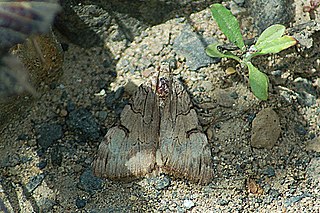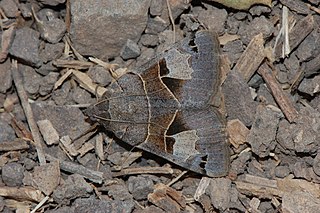
Drasteria is a genus of moths in the family Erebidae.

Drasteria cailino is a moth of the family Erebidae first described by Alexandre Louis Lefèbvre de Cérisy in 1827. It is found in southern Europe, the Near East and Middle East up to the western Himalayas in the east. In the Levant, several isolated populations are present in Lebanon, Syria and Israel.
Drasteria hudsonica, the northern arches, is a moth of the family Erebidae. The species was first described by Augustus Radcliffe Grote and Coleman Townsend Robinson in 1865. It is found from Alaska and Yukon to California, east to New Mexico and Manitoba.

Drasteria pallescens, the cowhead arches, is a moth of the family Erebidae. The species was first described by Augustus Radcliffe Grote and Coleman Townsend Robinson in 1866. It is found in North America from Alberta and Saskatchewan south to Texas and Baja California.
Drasteria petricola, the little arches, is a moth of the family Erebidae. The species was first described by Francis Walker in 1858. It is found in western North America from Yukon and the Northwest Territories south to New Mexico in the Rocky Mountains, east to Manitoba.

Drasteria grandirena, the figure-seven moth or great kidney, is a moth of the family Erebidae first described by Adrian Hardy Haworth in 1809. It is found in North America from Ontario, Quebec and Nova Scotia, south to at least Georgia west to at least Arkansas

Drasteria howlandii is a moth of the family Erebidae. It is found from British Columbia and Saskatchewan south through the western parts of the United States from Washington south to Arizona and Texas.

Drasteria ochracea is a moth of the family Erebidae. It is found from British Columbia south through the western parts of the United States from Washington south to Arizona.

Drasteria sabulosa is a moth of the family Erebidae. It is found from British Columbia south into the United States where it found as far east as Wyoming, Utah, Colorado, New Mexico and as far south as Arizona.
Drasteria tejonica is a moth of the family Erebidae. It has been recorded from California, Arizona, Colorado, Utah and New Mexico.

Drasteria edwardsii is a moth of the family Erebidae. It is found from Washington, through Oregon to California.
Drasteria ingeniculata is a moth of the family Erebidae. It is found in south-central United States.
Drasteria mirifica is a moth of the family Erebidae. It is found in North America, including Nevada, Oregon and California.

Drasteria fumosa, the smoky arches, is a species of moth in the family Erebidae first described by Strecker in 1898. It is found from the US state of California east to Utah and Texas.
Drasteria inepta, the inept drasteria, is a moth of the family Erebidae. It is found from Arizona to Texas, north to Colorado and Utah.
Drasteria yerburyi is a moth of the family Erebidae. It is found in Somalia, Eritrea, the United Arab Emirates, Yemen and Iran.

Drasteria caucasica is a moth of the family Erebidae. It is found in Romania, north-eastern Bulgaria, southern Moldova, southern Ukraine, Russia, Kazakhstan, Turkey, Daghestan, Armenia, Iraq, Iran, Turkmenistan, Uzbekistan, Tajikistan, Afghanistan, Pakistan, Kyrghyzstan, China and Mongolia.
Drasteria maculosa is a moth of the family Erebidae. It is found in North America, where it has been recorded from Nevada and California.
Drasteria pamira is a moth of the family Erebidae first described by Oscar John in 1917. It is found in Kyrgyzstan, Tajikistan and Afghanistan.

Drasteria picta is a moth of the family Erebidae first described by Hugo Theodor Christoph in 1877. It is found in Ukraine, Russia, Kazakhstan, southern Turkey, Syria, Armenia, Daghestan, Kyrgyzstan, Uzbekistan, Turkmenistan, Mongolia and China.










